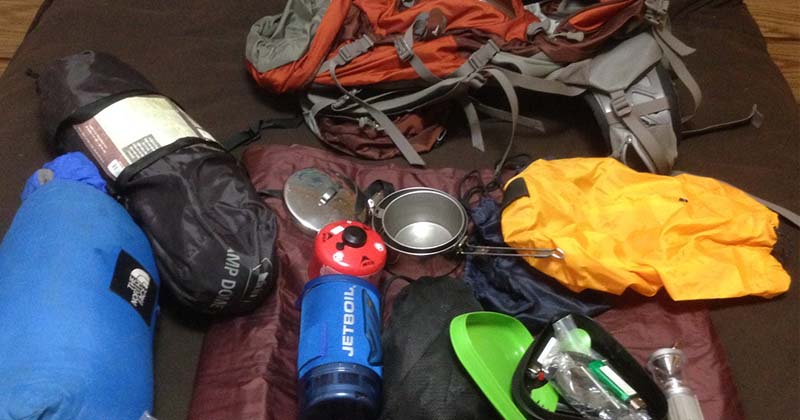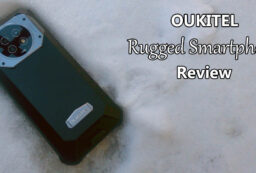Want to go backpacking or camping, but need to fly to the location? It can actually be really tricky – or impossible – to bring certain gear on an airplane. I’ll go over all the specifics of flying with backpacking gear, including stoves, bear spray and trekking poles.
Quick Summary:
When flying, you’ll need to check almost all of your backpacking gear. Keep spare lithium batteries as well as certain valuable or hard-to-replace items in your carry-on. To protect your pack and avoid additional inspection, put your pack inside a large duffel bag before checking it. Bear spray and fuel for your stove are completley forbidden on planes, so you’ll need to get these when you arrive at your destination.
Are Backpacks Allowed As Checked Luggage?
Backpacks are allowed as checked luggage. So long as it doesn’t exceed baggage dimension requirements, you shouldn’t have to pay extra to use a backpack instead of a suitcase. For most airlines, the maximum linear dimensions (L + W + H) cannot exceed 62 inches.
However, you might come across some issues when trying to check your pack.
- Some airlines will only accept backpacks as “fragile” luggage. If something like a strap or buckle breaks, they aren’t liable.
- You might have to go to the oversized baggage counter. I’ve had this happen to me. It isn’t a big deal, but it means you have to wait in another line. Which could mean you end up missing your flight.
Tip: Put your entire backpack inside a large duffle bag.
Or something similar like an Ikea bag or cardboard box. This will protect the straps. It also means your backpack won’t be considered “fragile” and you probably won’t be sent to the oversized luggage area.
Also, apparently airlines are only required to cover the interior contents of checked baggage but not the baggage itself. By putting your pack inside another bag, the pack itself would be covered for damages.
I’ve also heard stories of people having their gear confiscated or stolen out of their pack. Putting the pack inside a duffel bag limits visibility so you are less likely to undergo inspections and have anything taken.
There are a lot of good duffle bags. I like this REI duffel bag: a 65L pack plus boots and a jacket will fit in it. Osprey also makes the Airporter for this purpose. Most hotels will hold onto the bag for you so you don’t have to carry it while hiking. If not, then you put your backpack inside a large cardboard box. Then you can just toss the box when you arrive and not worry about storing it.
![]()
Is It Better to Just Mail Gear to the Destination?
In almost all cases, mailing backpacking gear to your destination is going to cost a lot more than paying for checked baggage. You might be able to make it work by bringing all your heavy/allowed gear as carry-on and mailing the rest, but it will still probably be cheaper and easier to just check the gear.
What Backpacking Gear is Allowed in Checked Luggage?
The TSA has a thorough list of which camping gear they allow on flights. Not surprisingly, a lot of backpacking gear isn’t allowed as carry-on, so it’s almost inevitable that you’ll need to pay for checked luggage.
Even if gear is allowed in carry-on, it’s still probably better to pack it in checked luggage. Why? Because it will be a pain when airport security makes you completely unpack your bag to inspect every piece of gear. There are some exceptions to this though, which I’ll talk about below.
Tents
The tent itself is allowed as carry-on, but tent poles and stakes must go in checked luggage. The stakes must be “sheathed or securely wrapped to prevent injury to baggage handlers and inspectors.”
Stoves
Camp stoves are allowed in both carry-on and checked baggage. However, the stove must be completely empty and clean. It’s generally better to keep your stove in checked baggage. Otherwise you risk delays at security as they inspect your stove. They might even say you aren’t allowed to take the stove. It’s generally useless trying to argue with security and explain that you cleaned it.
Fuel for Stoves
Fuel for backpacking stoves isn’t allowed in checked or carry-on baggage. This means your only solution is to get fuel when you arrive at your destination.
- Compressed Gas Canisters: Look for retailers at the destination. Especially when traveling abroad, make sure the canisters use the same nozzle as your stove. Don’t assume the canisters will be compatible.
- Alcohol: Alcohol stoves are also good for traveling abroad because it’s easy to find alcohol almost everywhere, though you might have a fun time explaining in a foreign language that you don’t want alcohol for drinking. 🙂
- Multi-fuel stove canisters: A lot of backpackers use a multi-fuel stove because you can pretty much always find gasoline. You can bring empty fuel canisters on checked or carry-on luggage. The canister must be labeled. All parts also must be completely disconnected – including the hose and regulator valves. Otherwise they will confiscate your canister and its parts.
Lighters
Lighters are surprisingly allowed on carry-on and checked luggage. They can even have fuel in them. However, they have to be disposable lighters or Zippo type lighters. You can’t bring electronic lighters (not sure why you’d want to bring one backpacking anyway though).
Bear Spray
Bear spray (as well as bear bangers) is not allowed in checked or carry-on luggage. This is particularly annoying because it’s not always possible to find bear spray at your destination. Plus, it is expensive to buy, only to leave it when you fly home.
Here are some solutions.
- Rent Bear Spray: Some National Parks rent bear spray. These include Yellowstone and Glacier. Some local gear outfitters also rent bear spray, so see if that is an option.
- Ask locals: You could also ask in local backpacker/hiking groups if someone could loan you their bear spray. People may surprise you with their kindness. 🙂
- Ship to your destination: In the USA, you can send bear spray in the mail. You’ll need to have an address to send it to though (some hotels might accept packages for guests). Note that bear spray has to be sent with ground mail and could take 2+ weeks to arrive.
Hiking Poles
Hiking poles aren’t allowed in carry-on but are allowed in checked luggage. Make sure they are inside your pack and not strapped to the outside.
Other Gear
- Crampons and snow spikes: Crampons are sometimes allowed in carry-on but, if they have any serious spikes, they have to go in checked baggage. They must be in a box or case so TSA doesn’t get poked if they open your gear.
- Hand warmers: Are allowed in carry-on and checked baggage.
- Potty trowel: If it is pointy, then play it safe and check it. TSA might consider it a sharp object like a knife.
Batteries and Power Banks
Rechargeable NiMH batteries are allowed in both carry-on and checked luggage. Lithium batteries are allowed in checked-luggage if they are in their device. However, spare lithium batteries – including power banks – are only allowed in carry-on. This is because, in some situations, lithium batteries can burst into flames and cause a fire in the cargo hold.
You will need to pack all power banks in your carry-on baggage. If you are bringing a solar panel with a built-in battery, it also has to go in carry-on.
You’ll also need to pack any spare lithium batteries you have, such as 18650 cells, so they are “protected from short circuit.” Basically, you can’t have a bunch of loose batteries in your bag. They should be in a case or sleeve. You can also put tape over the terminals or put each battery in its own plastic bag.
Unless you have some massive lithium batteries, there are no limits to how many spare lithium batteries you can bring in carry-on. Read the details of the rule here.
Gear That Should Go in Carry-On
There is some backpacking gear that I always leave in my carry-on. Basically, anything that is expensive and/or I wouldn’t be able to easily replace at my destination. For example, I would always keep these items in carry-on:
- Headlamps
- Water filter
- GPS
- Personal location device
- Camera
- Pricy jackets
Will Backpacking Water Filters Freeze in Checked Luggage?
All modern airplanes have temperature-controlled cargo holds. The cargo area might not be as warm as the cabin, but it does not get below freezing temperatures. So, you don’t have to worry about your hollow fiber water filter freezing.
Despite this, I still always pack my water filter (a Sawyer Mini) in my carry-on. It often isn’t easy to get water filters at your destination. If arriving somewhere which has Amazon and other next-day shipping services, this isn’t a big deal. But Amazon still isn’t available in many parts of the world. If your trip would be completely ruined if your water filter was lost, then keep it in carry-on.
Have a Backup Plan!
It doesn’t happen often, but airlines do sometimes lose luggage. Or you may have to wait for weeks while the airline “looks” for your lost luggage. Make sure you have a backup plan so you don’t have to completely cancel your trip.
Resources:
https://www.easa.europa.eu/domains/passengers/dangerous-goods
https://janetpanic.com/how-cold-does-the-luggage-compartment-of-a-plane-get/
https://avia-pro.net/blog/bagazhnyy-otsek-samoleta
https://www.united.com/en/us/fly/contract-of-carriage.html#rule-23
https://www.quora.com/At-what-temperature-is-checked-in-luggage-stored-in-an-airplane
https://www.reddit.com/r/Ultralight/comments/94wkzf/flying_with_backpacking_gear/
Image credit: “Organizing Backpack Gear” (CC BY 2.0) by cogdogblog













Post your comments